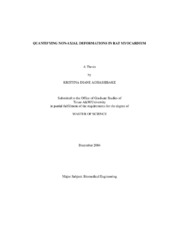| dc.contributor.advisor | Criscione, John C. | |
| dc.creator | Aghassibake, Kristina Diane | |
| dc.date.accessioned | 2005-02-17T20:59:13Z | |
| dc.date.available | 2005-02-17T20:59:13Z | |
| dc.date.created | 2004-12 | |
| dc.date.issued | 2005-02-17 | |
| dc.identifier.uri | https://hdl.handle.net/1969.1/1340 | |
| dc.description.abstract | While it is clear that myocardium responds to mechanical stimuli, it is unknown whether myocytes transduce stress or strain. It is also unknown whether myofibers maintain lateral connectivity or move freely over one another when myocardium is deformed. Due to the lack of information about the relationship between macroscopic and cellular deformations, we sought to develop an experimental method to examine myocyte deformations and to determine their degree of affinity. A set of protocols was established for specimen preparation, image acquisition, and analysis, and two experiments were performed according to these methods. Results indicate that myocyte deformations are non-affine; therefore, some cellular rearrangement must occur when myocardium is stretched. | en |
| dc.format.extent | 1907345 bytes | en |
| dc.format.medium | electronic | en |
| dc.format.mimetype | application/pdf | |
| dc.language.iso | en_US | |
| dc.publisher | Texas A&M University | |
| dc.subject | myocardium | en |
| dc.subject | strain | en |
| dc.subject | deformation | en |
| dc.subject | non-axial | en |
| dc.title | Quantifying non-axial deformations in rat myocardium | en |
| dc.type | Book | en |
| dc.type | Thesis | en |
| thesis.degree.department | Biomedical Engineering | en |
| thesis.degree.discipline | Biomedical Engineering | en |
| thesis.degree.grantor | Texas A&M University | en |
| thesis.degree.name | Master of Science | en |
| thesis.degree.level | Masters | en |
| dc.contributor.committeeMember | Yeh, Alvin | |
| dc.contributor.committeeMember | Laine, Glen A. | |
| dc.type.genre | Electronic Thesis | en |
| dc.type.material | text | en |
| dc.format.digitalOrigin | born digital | en |


